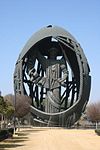The Puerta de la Macarena (in Arabic: Bab-al-Makrin), also known as Arco de la Macarena, stands alongside the Postigo del Aceite and the Puerta de Córdoba the only three city gates that remain today of the original walls of Seville. It is located in the calle Resolana, within of barrio de San Gil, which belongs to the district of Casco Antiguo of the city of Seville, in Andalusia, Spain. The gate faces the Basílica de La Macarena, which houses the image of the Our Lady of la Esperanza Macarena, one of the most characteristic images of the Holy Week in Seville.This is the entrance of the walls located further north of the city, and the biggest of the set, and is one of the few remnants that remain from the walls of the city, along with the cloth of the walls that it connects with the Puerta de Córdoba through a wall where seven towers are preserved. Although the enclosure walled of the city was built in time of Julius Caesar on the former Carthaginian defense, the gate corresponds to the extension made by the Sultan Ali ibn Yusuf in the 12th century, and its present appearance is the result of a remodeling carried out between the years 1723 and 1795, in which the Islamic architectural elements were replaced by the classicist air which presents today.It was the gate used by the kings who visited the city of the first time, and before its walls rose an altar in that performing their quarrel tribute, after which they were handed the keys of the city, and so did Alfonso XI of Castile (1327), Isabella I of Castile (1477), Ferdinand II of Aragon (1508), Charles V, Holy Roman Emperor and his fiancee Isabella of Portugal (1526), and finally Philip IV (1624).Crowns the set the ceramic altarpiece by painter Manuel Rodríguez representing the Virgin of Hope of Macarena, inaugurated in 1923 by the infanta Maria de la Esperanza of Bourbon-Two Sicilies.The remains of the walled city, which includes this gate, were declared Bien de Interés Cultural in 1985.












